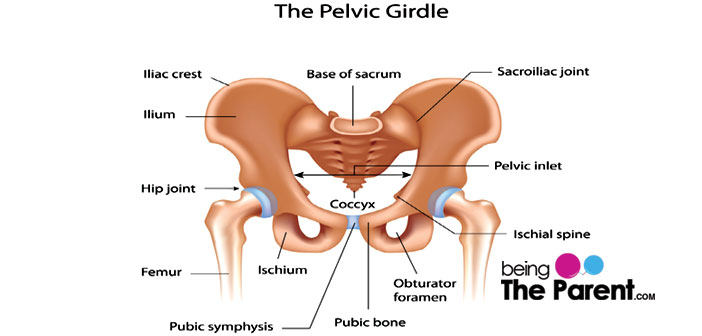
What Is Meant By Pelvic Pain?
Pelvic pain is the pain that is experienced below the belly button, between the hipbones (pelvic bones). The pain can be sharp or mild, can appear and disappear, and can be sudden and intense, depending on the reasons. Generally, pelvic pain is not a reason to panic
.
A majority of pregnant women experience pelvic pain, sooner or later, inevitably as the pregnancy advances. Most often pelvic pain is experienced during the last trimester as the bones and ligaments shift and stretch to accommodate the fetus and the strain on the pelvic area increases.
How Is Pelvic Pain Different From The Usual Abdominal Pain During Pregnancy?
Sometimes abdominal pain is mistaken as pelvic pain by some women. The abdominal pain that is experienced in the course of pregnancy is usually concentrated in the upper part of the body. Whereas, the pelvic pain happens over the pelvic region. The abdominal pains are less sharp than pelvic pain and remain almost constant irrespective if the expecting mother is lying down or walking. Whereas, the pelvic pain will get sharper and more noticeable during walking, climbing steps, standing on one leg (when wearing pants or panties or while getting in and out of the car etc.) or even tossing and turning in the bed.
What Is Pelvic Girdle Pain (PGP)?
The pelvic girdle is a bony arched structure in the hip area, which bears several bones and joints. Pelvic joint is mainly formed of two curved pubic bones meeting at the joint called the pubic symphysis , hip joint (which bear the weight of the body), and the sacroiliac joint (connecting the sacrum with the pelvis). Any mechanical issues happen to these joints usually leads to pelvic girdle pain (PGP).
There are two types of pelvic girdle pains, SPD (Symphysis pubis dysfunction) and DSP (Diastasis symphysis pubis). Though related to SPD, the DSP is not that common as SPD. DSP refers to a condition in which the pubic symphysis widens too far. An X-ray, ultrasound scan or MRI scan can only diagnose this condition.
What Is Meant By Pelvic Pain?
Pelvic pain is the pain that is experienced below the belly button, between the hipbones (pelvic bones). The pain can be sharp or mild, can appear and disappear, and can be sudden and intense, depending on the reasons. Generally, pelvic pain is not a reason to panic. A majority of pregnant women experience pelvic pain, sooner or later, inevitably as the pregnancy advances. Most often pelvic pain is experienced during the last trimester as the bones and ligaments shift and stretch to accommodate the fetus and the strain on the pelvic area increases.
How Is Pelvic Pain Different From The Usual Abdominal Pain During Pregnancy?
Sometimes abdominal pain is mistaken as pelvic pain by some women. The abdominal pain that is experienced in the course of pregnancy is usually concentrated in the upper part of the body. Whereas, the pelvic pain happens over the pelvic region. The abdominal pains are less sharp than pelvic pain and remain almost constant irrespective if the expecting mother is lying down or walking. Whereas, the pelvic pain will get sharper and more noticeable during walking, climbing steps, standing on one leg (when wearing pants or panties or while getting in and out of the car etc.) or even tossing and turning in the bed.
What Is Pelvic Girdle Pain (PGP)?
The pelvic girdle is a bony arched structure in the hip area, which bears several bones and joints. Pelvic joint is mainly formed of two curved pubic bones meeting at the joint called the pubic symphysis , hip joint (which bear the weight of the body), and the sacroiliac joint (connecting the sacrum with the pelvis). Any mechanical issues happen to these joints usually leads to pelvic girdle pain (PGP).
There are two types of pelvic girdle pains, SPD (Symphysis pubis dysfunction) and DSP (Diastasis symphysis pubis). Though related to SPD, the DSP is not that common as SPD. DSP refers to a condition in which the pubic symphysis widens too far. An X-ray, ultrasound scan or MRI scan can only diagnose this condition.
READ MORE
No comments:
Post a Comment